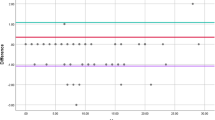Abstract
Introduction and hypothesis
The aim of this study was to evaluate the psychometric properties of the Persian version of the International Consultation on Incontinence Modular Questionnaire for Female Lower Urinary Tract Symptoms (ICIQ-FLUTS) in patients with urinary tract dysfunction.
Methods
After gaining permission from the International Consultation on Incontinence Modular Questionnaire (ICIQ) advisory board, the English Female Lower Urinary Tract Symptoms (FLUTS) questionnaire was translated into Persian and then translated back into English. One hundred fourteen women with pelvic floor dysfunction were asked to complete the Persian FLUTS and International Consultation on Incontinence Modular Questionnaire Overactive Bladder Questionnaire (ICIQ-OAB). The Persian FLUTS questionnaire was also readministered to 20 patients 2 weeks after their initial visit. Study data were analyzed using SPSS V16.0. To validate the translated questionnaire, we assayed content/face validity, internal consistency/reliability, and construct validity. Internal consistency and test–retest reliability were assessed using Cronbach’s alpha and the intraclass correlation coefficient (ICC) respectively.
Results
The mean age of the patients was 48.8 years old, 84% were married, and 59% had at least one Caesarean. Except for very few missing data, there is no any ambiguity in the Persian version of the FLUTS questionnaire. The Cronbach’s alpha was 0.83, indicating a high internal consistency. Concerning criterion validity, correlation between the Persian FLUTS and the OAB was 0.77 (p < 0.001).
Conclusion
The initial testing of the Persian version of the FLUTS questionnaire demonstrates good internal consistency, content validity, and reliability.
Similar content being viewed by others
References
Abrams P, Cardozo L, Fall M, et al. The standardization of terminology of lower urinary tract function: report from the standardization of terminology sub-committee of the International Continence Society. Neurourol Urodyn. 2002;21:167–78. doi:10.1002/nau.10052.
Irwin DE, Milsom I, Hunskaar S, Reilly K, Kopp Z, et al. Population-based survey of urinary incontinence, overactive bladder, and other lower urinary tract symptoms in five countries: results of the EPIC study. Eur Urol. 2006;50(6):1306–13. doi:10.1016/j.eururo.2006.09.019.
Boyal P, Robertson C, Mazzetta C, et al. The prevalence of lower urinary tract symptoms in men and women in four centres. The UrEpik study. Br J Urol. 2003;92(4):409–14. doi:10.1046/j.1464-410X.2003.04369.x.
van Breda HM, Bosch JL, de Kort L. Hidden prevalence of lower urinary tract symptoms in healthy nulligravid young women. Int Urogynecol J. 2015;26(11):1637–43. doi:10.1007/s00192-015-2754-1.
Homma Y, Yoshida M, Yamannishi T, et al. Core Lower Urinary Tract Symptom Score (CLSS) questionnaire: a reliable tool in the overall assessment of lower urinary tract symptoms. Int J Urol. 2008;15:816–20. doi:10.1111/j.1442-2042.2008.02121.x.
Gotoh M. Quality of life assessment for patients with urinary incontinence. Nagoya J Med Sci. 2007;69(3–4):123–31.
Heldwein FL, Sanchez-Salas RE, Sanchez-Salas R, et al. Health and quality of life in urology: issues in general urology and urological oncology. Arch Esp Urol. 2009;62(7):519–30.
Abrams P, Avery K, Gardener N, et al. The International Consultation on Incontinence Modular Questionnaire: www.iciq.net. J Urol. 2006;175(3):1063–6. doi:10.1016/S0022-5347(05)00348-4.
Brookes ST, Donovan JL, Wright M, et al. A scored form of the Bristol Female Lower Urinary Tract Symptoms questionnaire: data from a randomized controlled trial of surgery for women with stress incontinence. Am J Obstet Gynecol. 2004;191(1):73–82. doi:10.1016/j.ajog.2003.12.027.
Huang L, Zhang S, Liang S, et al. The Chinese version of ICIQ: a useful tool in clinical practice and research on urinary incontinence. Neurourol Urodyn. 2008;27(6):522–4. doi:10.1002/nau.20546.
Oh SJ, Park HG, Paick SH, et al. Translation and linguistic validation of Korean version of the Bristol Female Lower Urinary Tract Symptom Instrument. J Korean Continence Soc. 2004;8(2):89–113.
Tubaro A, Zattoni F, Prezioso D, et al. Italian validation of the International Consultation on Incontinence Questionnaires. Br J Urol. 2006;97(1):101–8. doi:10.1111/j.1464-410X.2006.05885.x.
Sari MR, Hajebrahimi S, Sadeghi-bazargani H, et al. Reliability and validation of the International Consultation on Incontinence Questionnaire in over active bladder to Persian language. Low Urin Tract Symptoms. 2014;7(2):1–3. doi:10.1111/luts.12059.
Alrubaiy L, Hutchings HA, Williams JG. Assessing patient reported outcome measures: a practical guide for gastroenterologists. United European Gastroenterol J. 2014;2(6):463–70. doi:10.1177/2050640614558345.
Fayers PM, Machin D. Quality of life: assessment, analysis and interpretation. Chichester: Wiley; 2007.
Acknowledgements
The study was approved by the Clinical Research Council of Isfahan University of Medical Sciences (ID:194011) and followed the related ethics guidelines. We thank our colleagues from Isfahan University of Medical Sciences and the Vice-Chancellery for Research for supporting this research.
Author information
Authors and Affiliations
Corresponding author
Ethics declarations
Conflicts of interest
None.
Rights and permissions
About this article
Cite this article
Pourmomeny, A.A., Rezaeian, Z.S. & Soltanmohamadi, M. Translation and linguistic validation of the Persian version of the Bristol Female Lower Urinary Tract Symptoms instrument. Int Urogynecol J 28, 1329–1333 (2017). https://doi.org/10.1007/s00192-017-3264-0
Received:
Accepted:
Published:
Issue Date:
DOI: https://doi.org/10.1007/s00192-017-3264-0



